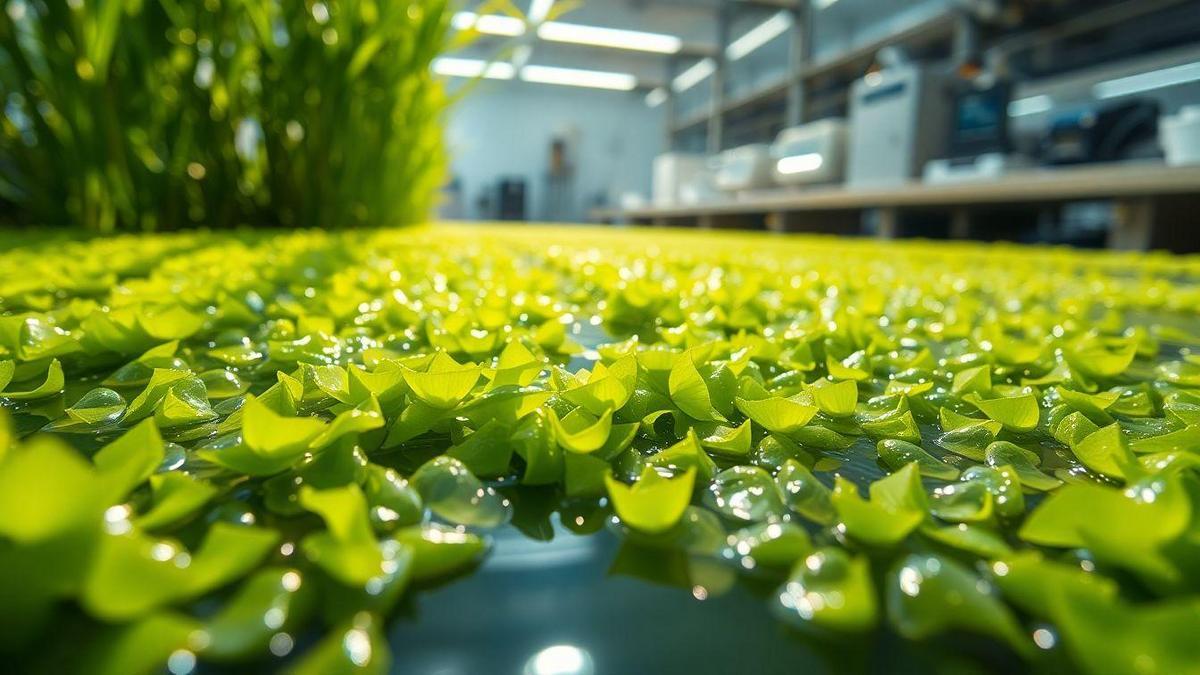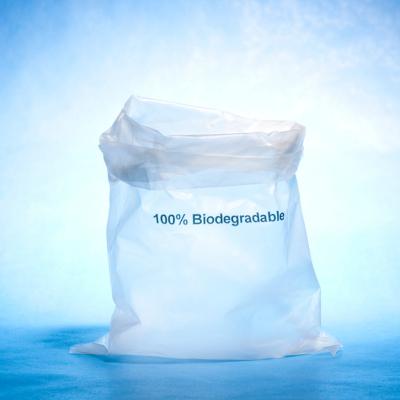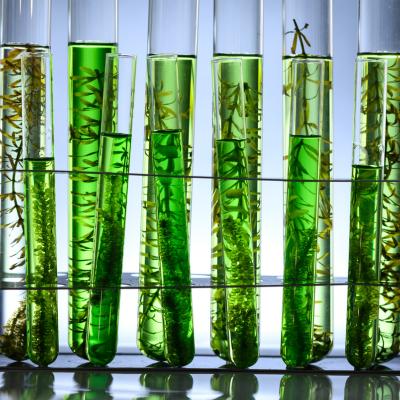Anúncios
The growing environmental impact caused by the excessive use of traditional plastics has driven the search for more sustainable alternatives. Among the emerging options, algae-based bioplastics have emerged as a promising solution, offering benefits for both the environment and various industries. This innovative material is produced from algae, which are renewable and possess characteristics that can be adjusted to meet different needs.
The production of algae-based bioplastics involves cultivating algae in controlled environments, followed by extraction and fermentation methods. The result is a biodegradable material with a reduced carbon footprint, offering an efficient alternative to petroleum-based plastics. In this context, understanding how these bioplastics work and their advantages can help promote a significant shift toward sustainability.
Anúncios

How Algae-Based Bioplastics Work
Algae-based bioplastics are innovative materials derived from algae biomass, providing a sustainable alternative to traditional petrochemical-based plastics. The creation process of these bioplastics begins with the cultivation of algae in controlled environments, where they are harvested for their high carbohydrate and protein content. After harvesting, the algae undergo various processing methods, such as extraction and fermentation, to convert their organic compounds into biopolymers. These biopolymers can be molded into various shapes, similar to conventional plastics, allowing for a wide range of applications.
The chemistry behind algae-based bioplastics involves transforming algae biomass into polymers such as polyhydroxyalkanoates (PHAs) and polylactic acid (PLA). PHAs are produced by certain bacteria that ferment sugars extracted from the algae, while PLA is synthesized from lactic acid, which can also be derived from algae sugars. These bioplastics exhibit properties comparable to their petroleum-based counterparts, such as flexibility, durability, and biodegradability, making them suitable for various uses in packaging, consumer goods, and even medical applications.
Additionally, algae-based bioplastics can be designed to enhance their performance characteristics. By modifying the composition of the algae biomass or incorporating additives, manufacturers can customize the physical and chemical properties of the bioplastics to meet specific requirements. This adaptability enables the development of materials that not only serve functional purposes but also reduce environmental impact, as they can decompose naturally over time, unlike traditional plastics that persist in the environment for centuries.
Algae-based bioplastics production also presents an opportunity for carbon capture and utilization. Algae are known for their ability to absorb carbon dioxide during photosynthesis, which means that cultivating algae for bioplastic production can contribute to reducing greenhouse gas emissions. This dual benefit of providing a sustainable material while also addressing climate change makes algae-based bioplastics an attractive option for industries seeking to improve their environmental footprint.
Benefits of Algae-Based Bioplastics as an Alternative to Petrochemicals

One of the main advantages of algae-based bioplastics is their sustainability. Unlike petrochemical plastics, which are derived from finite fossil resources, algae are renewable and can be cultivated in various environments, including oceans and freshwater bodies. This ability to grow rapidly and in diverse conditions makes algae a more sustainable raw material for plastic production. Furthermore, algae cultivation does not compete with food crops, as they can be grown on non-arable land and use wastewater, reducing pressure on agricultural resources.
Another notable benefit of algae-based bioplastics is their biodegradability. While traditional plastics can take hundreds of years to break down, algae-based alternatives can decompose naturally within months, under the right conditions. This property significantly reduces plastic pollution in landfills and oceans, addressing one of the most urgent environmental challenges of our time. By choosing biodegradable materials, consumers and manufacturers can contribute to a circular economy, where waste is minimized, and resources are reused.
Moreover, algae-based bioplastics have a lower carbon footprint compared to their petrochemical counterparts. Algae cultivation absorbs carbon dioxide, helping mitigate climate change. When these bioplastics are disposed of, they can naturally decompose or be composted, returning nutrients to the soil. In contrast, traditional plastics release greenhouse gases during production and incineration, contributing to global warming. By opting for algae-based bioplastics, industries can take a significant step toward reducing their overall environmental impact.
Lastly, the versatility of algae-based bioplastics opens up new possibilities for innovation in product design and manufacturing. These bioplastics can be engineered to have specific properties, such as increased strength, flexibility, or thermal stability, making them suitable for a variety of applications across different industries. From eco-friendly packaging solutions to durable consumer products, algae-based bioplastics offer a promising pathway to developing sustainable materials that meet the demands of modern consumers while protecting the planet.
How to Use Algae-Based Bioplastics in Daily Life
Incorporating algae-based bioplastics into packaging solutions is one of the most direct ways to promote sustainability in daily life. Many companies are already exploring the use of these bioplastics for food packaging, beverages, and consumer goods. By choosing products packaged in algae-based materials, consumers can help reduce the demand for traditional plastics and support businesses committed to environmental responsibility. This shift not only benefits the planet but also encourages more companies to invest in sustainable practices.
Using algae-based bioplastics in consumer products is another practical application. From utensils to personal care items, an increasing number of manufacturers are developing eco-friendly products made from algae-derived materials. Consumers can look for labels indicating the use of bioplastics and make informed decisions that align with their values. By choosing these sustainable alternatives, individuals can contribute to reducing plastic waste and promoting a healthier environment.
Implementing algae-based bioplastics in the food industry presents a significant opportunity for sustainability. These materials can be used for food containers, utensils, and even packaging films that are compostable and safe for food contact. Restaurants and food vendors can adopt algae-based packaging to minimize their environmental impact and attract eco-conscious consumers. This transition not only supports a greener food industry but also raises awareness about the importance of sustainable practices in food service.
Promoting algae-based bioplastics in manufacturing processes can lead to broader adoption of these materials across various sectors. By educating manufacturers about the benefits of using algae-based plastics, industries can transition to more sustainable production methods. This shift may involve investments in research and development to optimize the use of algae-based materials, ensuring they meet performance standards for different applications. Collaborative efforts among businesses, researchers, and policymakers can facilitate this move toward greener manufacturing practices.
Supporting algae-based bioplastics through recycling initiatives is crucial to maximizing their environmental benefits. Although these bioplastics are biodegradable, establishing effective recycling programs can help recover valuable resources and minimize waste. Communities can work together to raise awareness about the importance of recycling bioplastics and provide accessible facilities for disposal. By integrating algae-based materials into existing recycling systems, we can ensure that these innovative products contribute to a circular economy.
Educating the public about the benefits of algae-based bioplastics is essential for driving change and encouraging widespread adoption. Schools, organizations, and environmental groups can play a vital role in raising awareness about the advantages of algae-derived materials. Hosting workshops, seminars, and informational campaigns can inform consumers about the impact of their choices and inspire them to seek sustainable alternatives. By fostering a culture of sustainability, we can collectively work toward a greener future.
In conclusion, using algae-based bioplastics in everyday life offers numerous opportunities for individuals and industries. By incorporating these materials into packaging, consumer products, food services, and manufacturing processes, we can significantly reduce our reliance on traditional plastics and contribute to a more sustainable future. Through education and community efforts, we can promote the benefits of algae-based bioplastics and inspire others to join the movement toward a cleaner and healthier planet.
Did You Enjoy Learning About Algae-Based Bioplastics as an Alternative to Petrochemicals?

Learning about algae-based bioplastics opens a world of possibilities for sustainable living and environmental management. These innovative materials not only provide a viable alternative to petrochemical plastics but also help reduce pollution and mitigate climate change. As we continue to explore the potential of algae-based bioplastics, we can take significant steps toward a more sustainable future.
By embracing algae-based bioplastics, individuals and businesses can play a crucial role in shaping a greener world. As awareness grows, so too does the opportunity for innovation and collaboration in developing sustainable practices. Together, we can create a future where eco-friendly materials are the norm, benefiting both our planet and future generations.
Frequently Asked Questions
What are algae-based bioplastics?
Algae-based bioplastics are plastics made from algae instead of petroleum. They are more sustainable and help the environment.
How do algae-based bioplastics compare to conventional plastics?
Algae-based bioplastics are better for the planet. They break down faster than traditional plastics and are less polluting.
What are the benefits of algae-based bioplastics as an alternative to petrochemicals?
Algae-based bioplastics help reduce dependence on oil. They are also renewable and can reduce carbon emissions.
Are algae-based bioplastics safe to use?
Yes! Algae-based bioplastics are safe for many applications, such as packaging and everyday products.
Where can algae-based bioplastics be found in the market?
You can find algae-based bioplastics in eco-friendly products, food packaging, and other sustainable items.
